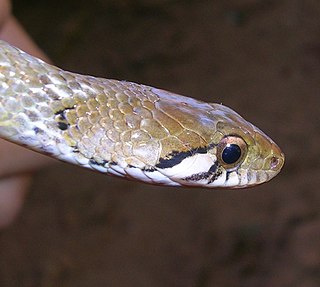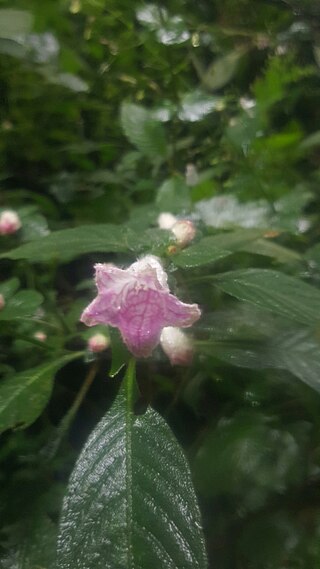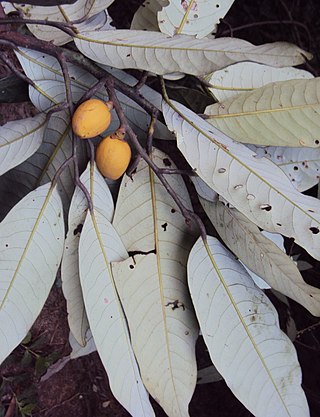
Acanthaceae is a family of dicotyledonous flowering plants containing almost 250 genera and about 2500 species. Most are tropical herbs, shrubs, or twining vines; some are epiphytes. Only a few species are distributed in temperate regions. The four main centres of distribution are Indonesia and Malaysia, Africa, Brazil, and Central America. Representatives of the family can be found in nearly every habitat, including dense or open forests, scrublands, wet fields and valleys, sea coast and marine areas, swamps, and mangrove forests.

The International Union for Conservation of Nature (IUCN) Red List of Threatened Species, also known as the IUCN Red List or Red Data Book, founded in 1964, is an inventory of the global conservation status and extinction risk of biological species. A series of Regional Red Lists, which assess the risk of extinction to species within a political management unit, are also produced by countries and organizations.

The Nilgiri keelback, also known commonly as Beddome's keelback, is a species of snake found in the Western Ghats in India. The species is named after Richard Henry Beddome, 1830–1911, British army officer and naturalist. It was first discovered near the Nilgiris but is now known more widely from the Western Ghats. This snake is terrestrial and feeds on toads.

Boiga beddomei, commonly known as Beddome's cat snake, is a species of rear-fanged snake in the family Colubridae. The species is endemic to the Western Ghats of India, in Maharashtra, Gujarat and Goa states.

Beddome's coral snake is a species of venomous snake in the family Elapidae. The species is endemic to hills of peninsular India.
Beddome's day gecko is a species of lizard in the Family Gekkonidae endemic to India.

Ophisops beddomei, commonly known as Beddome's snake-eye or Beddome’ s lacerta, is a species of lizard in the family Lacertidae. The species is a diurnal and fast-moving terrestrial lizard, which is endemic to the Western Ghats of India.

Dicliptera is a genus of flowering plants in the bear's breeches family, Acanthaceae. It includes 223 species native to the tropics and subtropics worldwide. Well-known synonyms include Peristrophe and Dactylostegium.

Cycas beddomei is a species of cycad in the genus Cycas, native to India, where it is confined to a small area of Andhra Pradesh state in the Tirumala Hills in scrubland and brush covered hills.

Cynometra beddomei is a species of tree in the family Fabaceae. It was described from a single tree in the Kerala Western Ghats of India. In 1998 it was declared extinct as it had never been seen again since 1870.

The lesser woolly horseshoe bat, also called Beddome's horseshoe bat, is a species of bat in the family Rhinolophidae. It is found in India and Sri Lanka. Its natural habitats are subtropical or tropical moist lowland forests, caves, and urban areas.

Acanthopale is a plant genus of shrubs or subshrubs in the Acanthaceae plant family. The genus name is based on the classic Greek words for thorn ákantha and stake palum. Some species in the genus are cultivated as ornamental plants.
Litsea beddomei is a species of plant in the family Lauraceae. It is endemic to India.

Myristica dactyloides is a species of plant in the family Myristicaceae. It is endemic to Sri Lanka. The species was earlier thought to occur in India because two subspecies of the related Myristica beddomei found in India, namely M. b. beddomei and M. b. ustulata, were wrongly identified as M. dactyloides Gaertn. in many herbarium specimens and regional floras.
Psychotria beddomei is a species of plant in the family Rubiaceae. It is endemic to Kerala in India.
Syzygium beddomei is a species of plant in the family Myrtaceae. It is endemic to Tamil Nadu in India.
Dicliptera aripoensis is a species of plant in the family Acanthaceae which is endemic to Trinidad and Tobago. The species is only known from the Heights of Aripo, in Trinidad's Northern Range. It is a branching shrub, 1–1.5 m tall with red flowers about 3 cm long.
A not evaluated (NE) species is one which has been categorized under the IUCN Red List of threatened species as not yet having been assessed by the International Union for Conservation of Nature. A species which is uncategorized and cannot be found in the IUCN repository is also considered not evaluated.

Hoppea fastigiata is a species of herbaceous plant in the family Gentianaceae. It is a small branched herb with oppositely arranged ovate, subsessile leaves. White flowers appear in terminal or axillary cymes. Flowering and fruiting season is September-October.












